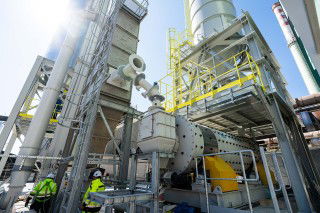This week HeidelbergCement released its 2020 Sustainability Report. In the 109-page document the company highlights the sustainability challenges ahead and its progress in terms of corporate sustainability management, environmental protection, employee welfare, workplace safety and social responsibility. For the first time, the company has aligned itself to the Task Force on Climate-related Financial Disclosures (TCFD) for reporting climate-related financial information. Moreover, the group is also now basing its remuneration systems on performance and results in terms of sustainable cement production.
CO2 reduction continues to rise up the agenda for the multinational. Its "Beyond 2020" strategy sets specific net CO2 emissions below 525kg/t of cementitious material produced, a 30 per cent reduction on 1990 levels. By 2030 the company has a target of below 500kg of CO2/t of cementitious material produced and carbon neutrality by 2050. The company achieved CO2 reductions of 23 per cent of the 1990 levels in 2020.
So that every employee is on board with the aims of the company's sustainability drive, alongside fixed salaries and contract work, employees now receive variable remuneration elements based on their individual performance and corporate success. The CO2 targets are consistently anchored in the group's global remuneration systems with full variable remuneration being achieved if both the financial and sustainability targets are met. This applies to board members and every bonus-eligible employee.
CO2 reduction projects coming to fruition
The CCS project at the company's Brevik plant in Norway is scheduled to start regular carbon capture by 2024 when 0.4Mta of CO2 will be captured and stored under the North Sea. In Slite, Sweden, the world's first carbon-neutral plant will be operational by 2030 and will aim to capture 1.8Mt of CO2 annually. Meanwhile, Low Emissions Intensity Lime and Cement (LEILAC) 2 pilot project aims to implement LEILAC technology on an industrial scale at the Hanover plant in Germany by 2025. HeidelbergCement is also participating in the development of oxyfuel technology for carbon capture (AC2OCem) as well as the catch4climate project. The group is also using its Edmonton plant in Canada for carbon capture and storage, where the organisation Emissions Reduction Alberta is providing a CAD1.4m (US$1.15m) feasibility study.
Meanwhile, HeidelbergCement has joined the HyNet North West consortium in the UK with the Hanson Padeswood cement plant set to be connected to the HyNet North West's CO2 transport and storage system. This project aims to reduce CO2 emissions by 10Mt by 2030, including 0.8Mta from the Padeswood cement plant.
Other projects to reduce CO2 include the use of algae cultivation at the Safi cement plant in Morocco where 50,000kg of microalgae are produced annually to manufacture fish food and animal feeds. The CO2MIN project aims to investigate the potential of natural minerals for absorbing CO2 and producing marketable building materials, while the C2inCO2 project will see calcium carbonate for the industrial sue of CO2, exploring the potential of adding CO2 to recycled waste concrete as a building material.
Sustainability Commitments
As the cornerstone of HeidelbergCement's sustainability strategy, the 2030 commitments were set in 2017 and revised in 2020. Among the chief targets and KPIs that will meet the TCFD reporting, HeidelbergCement has reduced its specific net CO2 emissions (kg CO2/t of cementitious material) from 598.6kg in 2018 to 576kg in 2020. The alternative fuel substitution rate has risen from 22 per cent in 2018 to 25.7 per cent in 2020 and has a target of 43 per cent in 2030. At group level, the proportion of alternative raw materials in cement production was 11.4 per cent in 2020.
Furthermore, SOx emissions have been reduced by 37 per cent between 2008-20 by the group, while NOx emissions have fallen by 22 per cent and dust has been reduced by 89 per cent in this period.
Meanwhile, the clinker ratio has also been reduced from 74.7 per cent in 2018 to 74.3 per cent in 2020. This is also affecting the types of cement produced by HeidelbergCement today. OPC is still the largest segment accounting for 37.4 per cent, but multi-component cements now account for 21.5 per cent of events, limestone cements now account for 19.7 per cent, slag cement's total 10.3 per cent, pozzolana and fly ash cements make up 7.7 per cent of the group's cements, GGBS account for 1.7 per cent, masonry cements/special binders total 1.1 per cent and oil well cements total 0.5 per cent.
Emissions trading
HeidelbergCement has 50 facilities in 16 countries participating in the EU Emissions Trading Scheme (EU ETS). HeidelbergCement expects a national Chinese emissions trading scheme to be introduced at some point while in North America, the Western Climate Initiative combines the Canadian and Californian ETS programmes.
Summary
Taking HeidelbergCement's lead, it is likely that we will see remuneration linked to sustainability performance more frequently going forward, as other cement groups seek to respond to demands from investors and other stakeholders on their environmental commitments. Meanwhile, its diverse range of CO2 reduction projects are set to start achieving beneficial results in the next few years, although significant amounts of investment will still be required to develop the successful technologies further, ready to be deployed globally. Plants that are unable to find individual solutions to their carbon reduction challenges could in the long-term face closure or disposal from the group.
